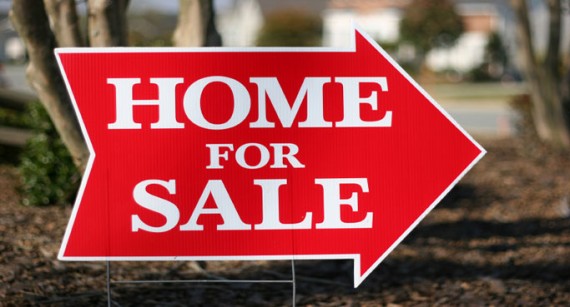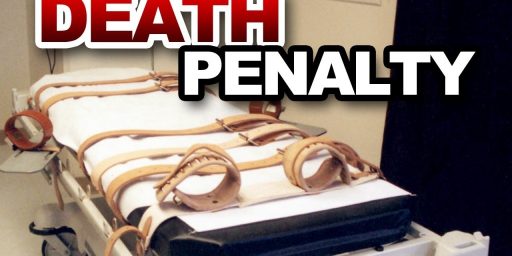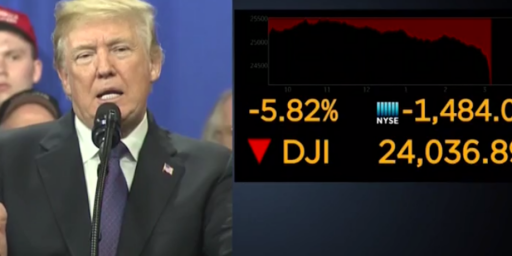Whatever Happened To The Housing Recovery?
Three years later, there are no signs that the real estate market is anywhere close to recovering.
In today’s New York Times, Floyd Norris points out that the real estate market remains as distressed as it was when the Great Recession started, and shows no signs of turning around any time soon:
PRICES for both homes and commercial real estate are falling again. Meaningful improvement may have to wait until there are many fewer distressed properties for sale.
Indexes of the two markets showed this week that the latest declines had almost wiped out the mild gains the two markets had shown after prices appeared to have hit bottom.
The Standard & Poor’s/Case-Shiller index of home prices ended February 3.3 percent below where it was a year earlier, and just 0.5 percent above the low reached in May 2009. The Moody’s/REAL Commercial Property Price Index was reported to be down 4.9 percent over the last 12 months, but still 0.8 percent above its low, reached last August.
In both cases, sales volumes are far below what they were when the markets were booming, and a large proportion of the properties that are being sold were in trouble before the sale. The National Association of Realtors estimates that about 40 percent of existing homes that changed hands in March were either in foreclosure or were so-called short sales in which the house was sold for less than was owed on the existing mortgage.
The commercial property index, which is based on data collected by Real Capital Analytics, shows that 29 percent of transactions in February involved distressed properties — including those already in foreclosure or default, as well as those whose owners had filed for bankruptcy.
“Only when the share of distressed sales meaningfully drops off will we be able to enter the recovery phase,” said Tad Philipp, Moody’s director of commercial real estate research.
This has been a problem in the real estate market ever since the housing bubble burst. As people started walking away from upside-down mortgages and bank portfolios started filling up with properties, home prices around the country dropped like a stone. Three years later, the inventory of foreclosed properties still hasn’t been exhausted, with the result being that prices has been essentially flat, as this chart shows:
![]() While there have been some fluctuations, home prices have been essentially flat since 2009, this despite the fact that during that period home prices were actually below the price it would cost to rent a home (as opposed to an apartment). Clearly, there’s an overabundance of supply on the market that is combining with an economy that remains stubbornly weak is keeping buyers from even thinking about making an investment in a home that, if the last few years are any indication, may not be worth as much as you paid for it in a few years.
While there have been some fluctuations, home prices have been essentially flat since 2009, this despite the fact that during that period home prices were actually below the price it would cost to rent a home (as opposed to an apartment). Clearly, there’s an overabundance of supply on the market that is combining with an economy that remains stubbornly weak is keeping buyers from even thinking about making an investment in a home that, if the last few years are any indication, may not be worth as much as you paid for it in a few years.
And then there’s the commercial real estate market. As the chart shows, prices there continued to rise for some time even while the housing market was starting to collapse, but the plunge came there as well, and when it did it was faster and deeper than what happened to residential real estate. You can see the impact of that in various parts of Northern Virginia, where newly built strip malls remains almost completely empty after several years. Moreover, just as in the residential market, there are a good number of commercial properties in distress:
According to data from Moody’s, hotels and apartments are in the most distress, with about 16 percent of loans in each category classified as delinquent. About 10 percent of loans on industrial property are in trouble, while the figures for offices and retail properties are lower, at around 7 percent.
Over all, the proportion of commercial loans in distress climbed from under 1 percent at the end of 2008 to over 9 percent now. But it has been stable in recent months, providing some hope that the market is no longer deteriorating.
Perhaps, but with increasing signs that the economic recovery may be stagnating, it won’t take much for the businesses that have to pay those commercial real estate loans to find themselves in trouble again. and if that happens all bets are off.







I love that for once I was right about real estate. Sticking with renting for another year.
Doug,
You hint at something here that is usually missed in discussions on housing bubble– that commercial real estate also saw the same thing. For those people who like to blame the bubble on things like borrowers being tricked by evil banks, or the flip side it being only Fannie and Freddie of the CRA, these stories don’t explain the CRE market. CRE investors are sophisticated – they weren’t victims of products they didn’t understand. On the flip side there weren’t as many government interventions supporting CRE like residential.
Whatever the explanation is either has to be something that affected both, or something that can show that one market was driven by the other. With everyone pontificating on why they think they know what happened, this angle is rarely discussed — and it should be if we actually are going to understand what truly did happen.
Doug –
For future reference it is not at all atypical for CRE to lag RRE. I used to have a website designated as a favorite with such data. I erased it and will have to do some homework.
ej –
You make a valid point, and I’m one of those who is critical of CRA and Fannie/Freddie. The numbers don’t lie, and I happened to be a lender years ago and witnessed with my own eyes and ears the threats made by regulators if the bank didn’t push CRA loans. Unless I was blind and deaf – or hallucinating – its real.
But there certainly are some other dynamics worth dealing with, as you say. Its to be pondered. But I would note that CRE borrowers are not nearly as sophisticated as you might imagine, although they certainly know what loan document provisions include. But market froth is what it is – it clouds judgment.
So much office and strip mall space (and hospitals/schools etc) was simply following – as supporting infrastructure – the migration of people building and buying homes. It was a market event in sympathy if you will. We looked at a number of companies for investment where this very effect was in place. As the resident skeptic I squelched them. And I was right.
As for common factors, one is EZ………EZ credit in both markets. And as you point out there was much less CRA in CRE, but again, it was material. I watched it happen. Both of these would be labeled under the common umbrella of lax credit standards.
In any event, the so called “shadow inventory” will eventually burn off. That’s the nature of recoveries. A thornier problem is going to be affordability. Inflation, taxation, loss of wealth in securities markets and current home RE all do not bode well. I’m thinking 5-7 years to recover in median to low priced markets.
.
There are also no signs that it was ever a problem, at least in Washington DC.
Drew,
Thanks for the thoughtful response. I’m not saying the GSEs or other policies weren’t in play here, but I don’t think they were the primary mechanism. I realize retail is closely related to housing development, but office space also saw a bubble, and hotels, and warehousing. There was a general real estate bubble.
As you mentioned — i see this having a lot to do with EZ credit and therefore a monetary phenomena — too much credit in the system leading to overleverage, which reinforced itself once you got the “irrational exuberance” building up. The general rise in commodity prices over this period would also suggest some monetary aspect. But was this too easy Fed policy, foreign capital inflows particularly from Asia? Some other kind of imbalance?
I’m open to other theories. I just wish people would bring the CRE component into this more.
And what’s frustrating from a public policy perspective, is the Dodd-Frank bill was passed in the name of preventing such messes, when no one really even knew what happened. The bill largely really was like the PATRIOT act, half doing something because the politicians have to look like they are protecting you and half to pass stuff certain interest wanted all along and using a crisis as the excuse to do so.
While prices remain low, 30%-40% below peak values–pending home sales in my part of FL are now at a six-year high. It’s not just the cheap real estate that’s moving, either; the most expensive house in Sarasota history just sold for $12.5 million.
In fact, it is the bottom that is not moving, largely due to real estate taxes that punish new buyers with higher rates than those who have been living in their homes for years. Sometimes, the difference can be measured in $10Ks. It’s presenting a problem as new buyers simply cannot afford the taxes on top of the mortgage payments.
There is definitely a commercial real estate glut, though, compounded by owners who try to jack up the rents to make themselves whole while forcing their renters out of business when they can’t/won’t pay the higher rents.
Recovery = Reinflated bubble?
Would it really be so bad if 5 million existing homes and 300-400 thousand new homes were sold each year?
” the flip side it being only Fannie and Freddie of the CRA, these stories don’t explain the CRE market.”
Dont forget international markets. Same thing happened there, w/o Fannie and Freddie. The CRA affected a small percentage of loans.
Drew- Calculated Risk has the charts on CRE and where it falls in a recession/recovery.
Steve
Steve,
Exactly. And in Ireland, Portugal and Spain, which all had big bubbles, the argument I hear that is most convicing to me to explian those was once they joined the Euro, their interest rates fell sharply. Essentially, thats an easy credit story too.
Leamer’s paper may have some of what you want also.
http://www.kansascityfed.org/publicat/sympos/2007/PDF/2007.08.03.Leamer.pdf
Steve
Who said there was going to be a housing recovery and what idiot believed him/her?
(and no, I did not read Dougs post, but color me SHOCKED…. SHOCKED… that the housing bubble has not yet played itself out.)
Markets tend to take care of themselves. If we could just get government to get out of the market management business. A quick look at this administration will reveal a lot of theorists and very little experience. But then I forgot. Marxist do not believe in the private ownership of property.
Why does one assume that the measure of a recovery is that prices recover to their hyper-inflated bubble highs?
Wouldn’t that be indicative of a reinflation of the bubble rather than an actual recovery?
Various – I think you will find that when markets become irrational they have few boundaries. I have always posited that the roots of the housing bubble started here, with CRA/Fannie/Freddie. From there, the tulip bulb craze proliferated………….fueled by EZ credit everywhere.
You can all posit your own views, but when you actually were a lender, and in meetings where your institution was threatened by bank regulators if you didn’t make patently stupid CRA loans, and you know what the credit risk committee response was: offload them from our balance sheet to F&F………it all rings hollow. How’s our current Chief Academic – Benanke – doing on inflation??
ej – Don’t get me started on Dodd-Frank. I’m in the private equity business and this is the ultimate exculpatory bill for incompetant and crooked pols. These guys should be jailed.
There is no question that the US has subsidized home ownership, and that helped push up home valuesin a long, long, trend.
I think that can be separated. We had an inflection in the graph, we went from growth to a full blown bubble. That happened with secularized loans, lowered standards, corrupt ratings, and MBS.
Had we only had CRA, Freddy and Fannie, we might still be in a slow build.
Oh, add of course the mortgage interest rate deduction as an early contributor to house price inflation.